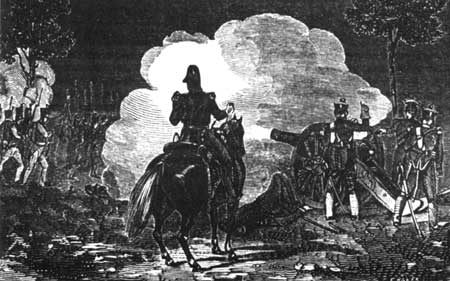|
CHALMETTE National Historical Park |
 |

Confused fighting and marching in the dark,
illuminated momentarily by flashes of gunfire—such was the battle
of December 23.
Photocopy by Dan Leyrer from Frost's
Pictorial Life of Andrew Jackson.
The Mud Rampart
Jackson and his officers knew that their men, mostly militia and recruits, could not stand up to a bayonet attack by the British veterans in daylight and in the open. Leaving cavalry to watch the enemy, they withdrew soon after dawn on December 24 to the Rodriguez Canal, the best defensive position in the vicinity.
The Rodriguez Canal formed the boundary between the Chalmette and Macarty plantations. Years before, this shallow ditch on the shortest line between river and swamp had been used as a millrace. When the river was higher than the land, river water had operated a small mill and had drained into the canal. Directly astride the British route of advance across the Chalmette plantation, it was 2 miles from the scene of the Night Battle and 6 miles from the center of New Orleans.
Along the Rodriguez Canal, Jackson's men began to build the mud wall behind which a motley army would defend New Orleans against three attacks. City and surrounding country were ransacked for tools and men. The ground was much too wet for trenches. Fence rails were driven into the soil along the canal and dirt piled against them. By nightfall, the mud wall had the semblance of a field fortification but the work went on one shift relieving another. Jackson himself was seldom out of the saddle, day or night. (Nearly 5,000 miles away, in Ghent, Belgium, the British and American envoys signed a treaty of peace on that Christmas Eve.)
On the morning of the 24th, the Louisiana came downstream and anchored about a mile from the Carolina. Whenever redcoats showed that day, their appearance was followed by cannon fire from the ships. The British advance was effectively pinned down. During the day, troops from the British fleet landed at the Villeré plantation, and the advance withdrew after dark to join them out of range of the American ships' guns.
In the days following, Americans cut the levee below the Rodriguez Canal. This flooded the plain between their army and the British, but the river soon subsided and left the plain dry. Work continued on the mud wall. A threat of attack on New Orleans from the northeast proved false, so General Carroll and his men moved to Jackson's line on the 26th. Pierre Lacoste's battalion also moved here.
Meanwhile, General Pakenham had arrived to take command of the British. His arrival on Christmas Day brought a momentary lift to the spirit of his depressed troops, but the situation of Pakenham and his second in command, Sir Samuel Gibbs, was not good. The terrain made it hard to reinforce and supply their troops, and this difficulty was increased by the shortage of pack animals. The Americans held a wall of mud, men, and artillery across the only dry ground on the way to the city which Pakenham had come to take. He must either break through that line or try another route. He decided to try for a break-through.
First, however, Pakenham felt he must rid himself of that intolerable nuisance, the Carolina, that kept shooting at the flanks of his army. So heavy guns and howitzers were brought from the fleet, and a hot shot furnace was built. Early on the morning of the 27th, British gunners began firing red-hot balls into the Carolina, which caught fire and blew up. Now Pakenham was ready.
That evening, the British drove in the American outposts by a show of superior force, and established artillery within range of the American lines. In withdrawing, the Americans blew up the buildings of Chalmette's plantation to give their own artillery a clearer field of fire.
The defenders had been strengthening their position in other ways. The crew of the Louisiana had towed that vessel out of range, thus saving for a few days the only remaining armed ship on the river.
Some guns from the Carolina had been saved and mounted on Jackson's line. Expert gunners from Barataria manned a battery. Two regiments of Louisiana Militia had been added to the force behind the mud wall.

|
|
Last Modified: Mon, Dec 2 2002 10:00:00 am PDT |


